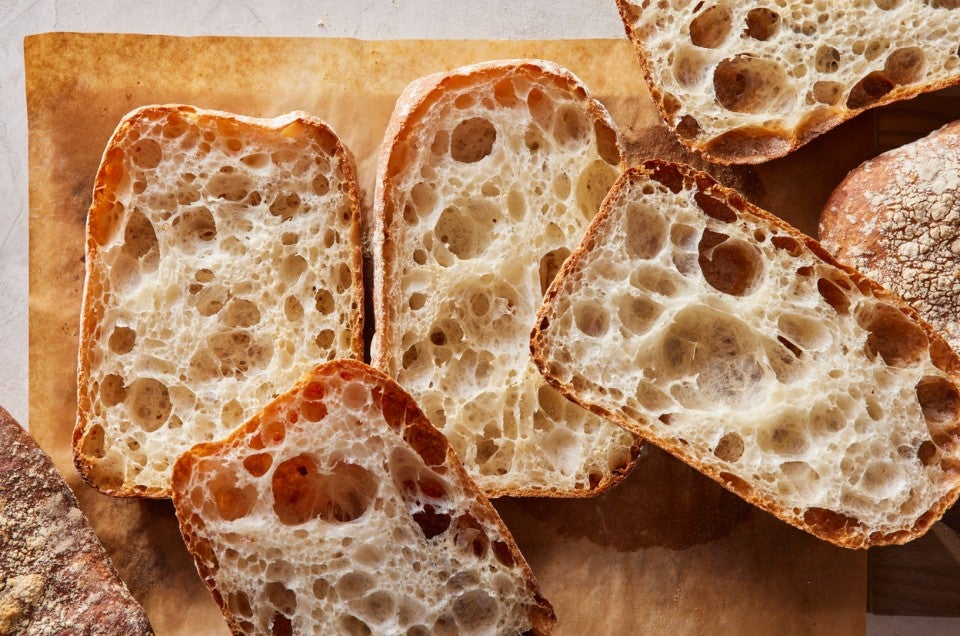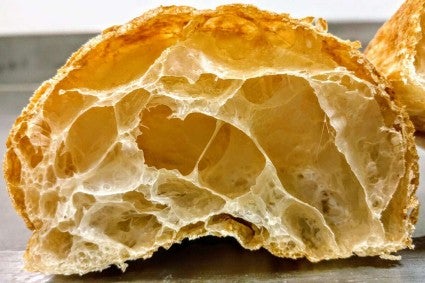Glass bread tastes as good as it looks (and it looks really, really good)
A beautiful bread made possible by bread flour.


 Recently I saw a loaf that stopped me in my tracks. It was a loaf that looked like it had all the qualities of a great bread: flavor, texture, sustenance. And most of all, beauty. Beauty, after all, is half the reason I bake. (Haven't you ever made something just because it’s gorgeous?)
Recently I saw a loaf that stopped me in my tracks. It was a loaf that looked like it had all the qualities of a great bread: flavor, texture, sustenance. And most of all, beauty. Beauty, after all, is half the reason I bake. (Haven't you ever made something just because it’s gorgeous?)
That loaf turned out to be Pan de Cristal, a traditional loaf from the Catalan region of Spain sometimes referred to as "glass bread." The outside of this loaf is unassuming — dark and crusty — and not exactly a showstopper. But wait. Hidden inside, lurking like crystals underneath a crust so crisp it seems fried, is a miraculously beautiful crumb. Threads of gluten stretch into glassy, translucent webs. Is it bread, I thought, or is it treasure?

It's both. And that’s what drew me in. I started asking questions: What magic makes Pan de Cristal possible? Will the recipe require days of attention, special flours, or mystical hands to transform four simple ingredients?
Luckily, I found the answers.
When I explore something new, I always start with architecture. In baking terms, what I mean is that I look inside the loaf at the structural components and ingredient ratios. I also consider method — the mixing, fermentation, and baking — and come up with a list of questions. You’ve seen me do this before from chocolate bread hacks to twists on traditional favorites.
The hydration will need to be dangerously high, around 100% in baker’s percentages (meaning, equal weights of flour and water). Compare this with baguettes (in the range of 65% to 75%) or ciabatta (around 80%), and you may be concerned. I don’t blame you. As designed, the dough will feel more like a batter than bread.
For leavening, I choose commercial yeast. The acidity of a sourdough culture isn't the flavor profile that I want. Let’s keep it simple: malty wheat, a well-baked crust, a drizzle of olive oil. Plus, I have time goals: I’d love to make this bread in a single afternoon. No preferment and a little commercial yeast will speed up the process.
Then there's fermentation. The dough will need time and folds to develop the necessary strength for its final proof. I'm not sure how much of each, but I do know that we’re chasing miracles here. This brings me to the crux of the challenge: How will it be possible to push this wet dough to the edge of its rise without collapsing?
Here’s how: Bread flour.

Sometimes baking requires a superhero. Bread flour, with enough strength to hold tons of water and support a long final proof without collapsing, is the caped hero we need. All-purpose could work but I would need to lower the hydration, sacrificing a key requirement for Pan de Cristal’s signature open structure.
Bread flour is also integral to creating a dough that's smooth, silky, and workable, despite the high hydration.
Early attempts involved yeasted preferments and lots of mechanical mixing. While the bread I made was flavorful, the crumb wasn’t much better than my ciabatta. Back to the drawing board.
First up, I needed to fix the most defining characteristic for this loaf: the holes. Since a long process with extensive mixing didn’t produce what I wanted, I went in the opposite direction: less mixing and a shorter process. My thought was that too much strength as a result of either development (mixing, folding, or time being the contributing factors) or fermentation, made my crumb structure too homogenous, not wildly open.
After several bakes with adjustments to mixing, number of folds, length of fermentation, and final rise, I found myself getting closer. The holes started to open, creating a collage of glassy, translucent bubbles, all connected within a network of random threads. The crust became thinner and crispier as I pushed the final rise further and further. As my cutting board was taken over by the piles of loaves, I began cutting them open as a parlor trick, shocking my family with the incredible results.
But rather than taking a bow after, “Wow, daddy, that’s amazing,” let’s give credit where it’s due. Please stand, a round of applause for bread flour — strong, elastic, ready for all the water and fermentation we can throw at it — the true star of this show.
So, if you'd like to see this transformation in action, give the recipe a whirl. Mix the dough just before noon, fold a few times between errands, Zoom meetings, dinner preparation, and life, and you'll have a hero at the table by dinnertime. Cue the applause!

In testing, enjoying, and sharing many loaves of Pan de Cristal, here are some things that I found helpful.
Just keep folding. On the flip side, if your dough doesn't match my above video exactly, or if you feel like it's more suited for pancakes than Pan, keep going. Unless there's a mistake with your measurements of flour or water, and as long as you're using great flour, the dough will definitely come around.
If you make this Pan de Cristal, please let us know — tag your photos #bakeoftheweek and maybe give @kingarthurbaking a shout-out, too. Happy baking!


February 6, 2022 at 1:05pm
In reply to Yes, I think this would be… by Amy (not verified)
Hi Amy! The video demonstration and Q&A session with Martin is viewable on our Instagram page as one of our posts on our page King Arthur Baking Company. Unfortunately, this is the only platform this content is currently viewable. Happy baking!
January 23, 2022 at 2:52pm
What can you do if you do not have a peel or baking stone?
January 23, 2022 at 3:19pm
In reply to What can you do if you do… by Marion M. Balch (not verified)
Hi Marion! You will definitely want a preheated surface to load your dough onto to ensure a high rise. If you don't have a baking stone, you could theoretically use an uncovered Dutch oven as well. A baking sheet would not be able to do the trick as it is a bit low on heat tolerance for 475 degrees. However, a baking sheet can be used as a transfer peel but using it upside down to slide the dough and parchment into the oven. Happy baking!
January 23, 2022 at 2:23pm
Could you use a Challenger Bread Pan? With or without the cover? Thanks
January 23, 2022 at 2:24pm
In reply to Could you use a Challenger… by SStory (not verified)
You certainly could use a Challenger bread pan, Sstory! I would recommend baking it without the lid on and still transferring to the upper rack midway through the bake if you are baking in rounds. Happy baking!
January 23, 2022 at 2:15pm
Can this bread be baked in a cast iron Dutch oven?
January 23, 2022 at 2:23pm
In reply to Can this bread be baked in a… by Cindi L (not verified)
Hi Cindi! You certainly can make this in a Dutch oven. I would recommend preheating the cast iron Dutch oven thoroughly just like the baking stone and baking the dough uncovered. When it comes time to move the doughs to the upper rack you will also follow the recipe in the same way and place the half baked dough directly on the upper rack of the oven to allow for the oven to Dutch oven to get back up to heat. For a crispier crust, you could bake them with the lid on in the first part of the bake, but it is not necessary. Depending on the size of your Dutch oven, you may need to bake them in more rounds or different shapes to accommodate the space. Happy baking!
January 23, 2022 at 1:27pm
Thermopen thermometers can be quite expensive. The ThermoPop thermometer by ThermoWorks is very affordable and works wonderfully.
January 23, 2022 at 11:17am
Yesterday I made this bread. I had some success. I thought I would pass on my experiences. The notes state that this is a dough like pancake batter. They are correct, it is "loose" or runny. I looked at the recipe and saw 500 grams of water and 500 grams of flour and thought "oh boy this is going to be interesting". Well, nothing ventured is nothing gained. So onward! Everything was mixed and yes, it is like pancake batter. I used a bowl hold the fermenting dough. Go with the recommended square pan to hold the dough. It was hard to make the folds using a bowl. Not impossible but perhaps easier with a larger pan than my bowl. I folded and folded, and circle folded to get the dough to some sort of strength to hold a loaf shape. Oh, it would raise up in the bowl to a beautiful size. The dough is fragile and weak and will need a container to hold to a loaf. But I could not get it to a strength to hold to a loaf like structure. I thought maybe one of those perforated baguette pans would work for me. But the dough was too loose and would ooze though the perforations before the dough would raise up. Maybe parchment paper would help but I wondered about the amount of water and what may happen to the paper. So, I started losing focus. I put everything in a 9-inch square casserole pan and let the dough raise up again. And then I baked it and wondered how that was going to work out. The 9-inch dish did work out. The bread was not what I originally thought it would look like. It did bake through. With butter on it, it sure is good. Those thin stretches of dough between the larger holes are crisp - like glass or ice. The taste was better than I thought it would be. Would I do this project again? Probably. but next time I need to figure out how to strengthen the dough, so it shapes better.
This is a watery sticky dough. Keep your fingers wet or they become covered with dough during the folding process. Use a bowl scraper to clean those bowls and wash them before the dough hardens. I think this takes an adventuresome baker or someone that has high hydration dough experience. For me it was an adventure. I will re-read the recipe and look for more tips and probably try it again.
January 23, 2022 at 4:25pm
In reply to Yesterday I made this bread… by Alan Jensen (not verified)
Thanks for sharing your notes, Alan! I think the best way to improve your rise would be giving the dough enough strength through folds and time to allow it to sit upright on a piece of parchment unaided. That way, you can use a peel and load the dough onto a baking stone to obtain maximum rise in the oven rather then loading it in on a cold vessel. Feel free to give our baker's hotline a call and discuss your process at 855-371-2253. Happy baking!
Pagination